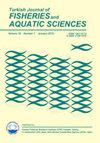Hotspot Habitat Modeling of Skipjack Tuna (Katsuwonus pelamis) in the Indian Ocean by Using Multisatellite Remote Sensing
IF 1.7
4区 农林科学
Q3 FISHERIES
引用次数: 1
Abstract
Skipjack tuna (SKJ) is one of the most targeted fish species globally, especially in the Indian Ocean. SKJ fishery data from Iranian purse seiners and multisatellite remote sensing data were used for hotspot habitat modeling from 2010 to 2018. Spatial and temporal variables were the most important predictors in the generalized additive model (GAM), and 58.6% of the variance was explained. In the MaxEnt model, sea surface temperature (SST), eddy kinetic energy (EKE), and sea surface height (SSH) were the most important predictors of SKJ hotspot habitat suitability in the tropical Indian Ocean between 2°S and 2°N. Furthermore, of the total studied area in the Indian Ocean defined as optimal habitat (habitat suitability index>0.6), 6.8% and 5.3% exhibited ordinary habitat suitability (AUC=0.934, P<0.01) and hotspot habitat suitability (AUC=0.952, P<0.01), respec tively. Iranian purse seiners are distributed mainly in tropical areas, and in the present study, SKJ habitat was affected by environmental variables, as determined using multisatellite remote sensing data. In general, for effective regional monitoring and management strategies to ensure sustainable fisheries, diverse datasets compiled using satellite datasets and habitat modeling can help identify potential hotspot habitats, thereby enabling more accurate suitable habitat zone predictions and more efficient stock management.利用多卫星遥感技术建立印度洋鲣鱼(Katsuwonus pelamis)的热点栖息地模型
鲣鱼(SKJ)是全球最受关注的鱼类之一,尤其是在印度洋。2010年至2018年,伊朗围网的SKJ渔业数据和多卫星遥感数据被用于热点栖息地建模。空间和时间变量是广义加性模型(GAM)中最重要的预测因素,58.6%的方差得到了解释。在MaxEnt模型中,海面温度(SST)、涡动能(EKE)和海面高度(SSH)是2°S至2°N热带印度洋SKJ热点栖息地适宜性的最重要预测因子。此外,在印度洋被定义为最佳栖息地(栖息地适宜性指数>0.6)的总研究区域中,6.8%和5.3%分别表现出普通栖息地适宜性(AUC=0.934,P<0.01)和热点栖息地适宜性。伊朗围网主要分布在热带地区,在本研究中,根据多卫星遥感数据确定,SKJ栖息地受到环境变量的影响。总的来说,为了确保可持续渔业的有效区域监测和管理战略,使用卫星数据集和栖息地建模汇编的各种数据集可以帮助识别潜在的热点栖息地,从而实现更准确的合适栖息地区域预测和更高效的种群管理。
本文章由计算机程序翻译,如有差异,请以英文原文为准。
求助全文
约1分钟内获得全文
求助全文
来源期刊

Turkish Journal of Fisheries and Aquatic Sciences
FISHERIES-MARINE & FRESHWATER BIOLOGY
CiteScore
3.10
自引率
0.00%
发文量
43
审稿时长
3 months
期刊介绍:
Turkish Journal of Fisheries and Aquatic Sciences" (TrJFAS) is a refereed academic journal has been published by Central Fisheries Research Institute of Turkey and Japan International Cooperation Agency (JICA), and published in English.
It aims to address research and needs of all working and studying within the many varied areas of fisheries and aquatic sciences.
The Journal publishes English language original research papers, critical review articles, short communications and technical notes on applied or scientific research relevant to freshwater, brackish and marine environments.
TrJFAS was published biannually (April & November) between 2001 and 2009. A great number of manuscripts have been submitted to the journal for review from acceptance of the SCI index. Thereby, the journal has been published quarterly (March, June, September and December) from 2010 to 2017. The journal will be published monthly in 2018.
 求助内容:
求助内容: 应助结果提醒方式:
应助结果提醒方式:


